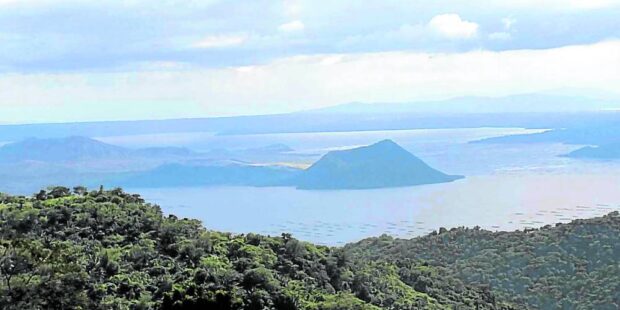
NOT SO CALM The scenic Taal Volcano looks calm in this photo taken on Friday morning from Tagaytay City, Cavite, but it actually emitted a high level of sulfur dioxide the day earlier, posing health threats to residents in its surrounding areas. —PHOTO COURTESY OF JILLIAN THERESE DUMAS
LUCENA CITY—Following the record-high volume of sulfur dioxide (SO2) spewed by Taal Volcano in Batangas province on Thursday, experts warned anew of health risks posed by volcanic smog or vog on residents near the area.
The volcano emitted 11,499 metric tons (MT) of SO2 that day, its highest this year, according to the Philippine Institute of Volcanology and Seismology (Phivolcs) on a bulletin on Friday.
Jillian Therese Dumas, a resident of Barangay Tolentino East in Tagaytay City, which is part of Cavite province and overlooks Taal Lake and the volcano, said she sent her two children to school on Friday morning wearing face masks for protection.
“My children hesitated at first, but I insisted that they wear it for their protection, especially if the vog envelops the city again,” Dumas told the Inquirer in a phone interview.
The mother of three said Taal Volcano, as seen from their house, still looked calm and without any signs of trouble, “but there is a whiff of sulfuric smell every time the wind blows.” Dumas recalled that in September, her children—age 10, 6 and 2—suffered from coughs after the volcano emitted thick vog.
She said family members, particularly the elderly, have prepared N95 face masks in case the situation worsens.
“It is better to be prepared than to be sorry later. The gas from the volcano is toxic, especially for the elderly,” said Sheila Tan, 70, another Tagaytay City resident, over the phone.
Vog consists of fine droplets containing volcanic gas such as SO2, which is acidic and could cause irritation of the eyes, throat and respiratory tract with severity depending on the gas concentration and duration of exposure.
Seaborne patrol
Phivolcs and local authorities warned that people particularly sensitive to vog are those with health conditions such as asthma, lung disease and heart disease, the elderly, pregnant women and children.
In Batangas’ Talisay town, police officers and personnel from the local government disaster management office patrolled Taal Lake on Friday to prevent unauthorized entry to the Taal Volcano Island (TVI), locally known as Pulo, which sits in the middle of the lake and has been declared a permanent danger zone by the authorities.
The Pulo, following the volcano’s major eruption on Jan. 12, 2020, has been off limits to all human activities. The volcano had been relatively quiet until July 11, 2022 when Phivolcs placed it under alert level 1 after it showed signs of low level of unrest.
Since then, the volcano had been periodically spewing SO2 and vog that had prompted its surrounding affected localities to suspend classes or require residents to wear face masks at all times. Phivolcs on Friday said its latest visual monitors showed “continued pronounced upwelling of volcanic fluids in the main crater that generated rather short and weak- to moderate-volume degassing plumes.”
The agency said that strong winds drifted the plumes to the southwest, but no volcanic smog or vog over Taal Caldera was observed throughout the day.
Stay alert
But Phivolcs’ wind forecasts indicated a probable weakening of wind, which may lead to potential SO2 accumulation and vog formation over the Taal region.
Phivolcs reminded the public that Taal Volcano is still in an “abnormal condition” and “should not be interpreted to have ceased unrest nor ceased the threat of eruptive activity.”
Under alert level 1, sudden steam-driven or phreatic explosions, volcanic earthquakes, minor ash fall and lethal accumulations or expulsions of volcanic gas can occur and threaten areas within TVI, Phivolcs said.
Phivolcs said entry into the Pulo, especially the vicinity of the main crater and the Daang Kastila fissure, as well as human activities on Taal Lake, must remain prohibited.
Should an uptrend or pronounced change in monitored parameters forewarn of renewed unrest, the alert level may be raised back to alert level 2, Phivolcs warned.